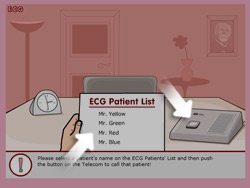
1.
Select a patient on the ECG Patients' List and then push the button on the telecom to call that patient!
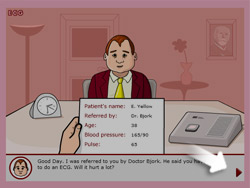
2.
Click on the red arrow at the bottom right corner to proceed!
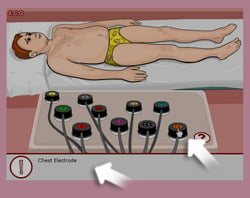
3.
Move the mouse cursor over an electrode and you'll see where to put it. Drag the electrode with the mouse corsor to the proper place on the patient and drop it. If you want to see how all electrodes are put – click on the question mark at the bottom right corner.
If you proceed with the other three patients later on, an "auto"-button will appear so you don't have to do this more than once.
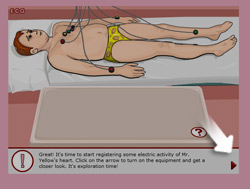
4.
When ready, move on by clicking on the little red arrow at the bottom right corner.
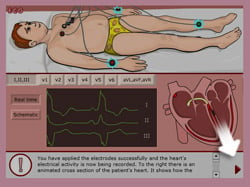
5.
Look at the animated picture of the patient's heart and see if you can find anything unusual.
(In a normal, healthy heart, the initial impulse will be regular and steady and there will be nothing obstructing the electric wave spreading through the heart muscle tissue.)
Click on the red arrow when you are ready to proceed.
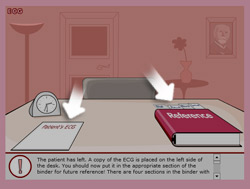
6.
A copy of the patient's ECG is placed on the left side of the desk. You should now put it in the appropriate section of the binder for future reference! There are four sections in the binder with a couple of sample ECGs showing four common conditions. See if you can decide which section of the binder to put your ECG copy in! Move the mouse cursor over a tab to see what a section contains and click to open the binder to that section. To put the ECG in the binder section of your choice, simply select the appropriate condition from the menu at the bottom of the ECG you have just obtained.
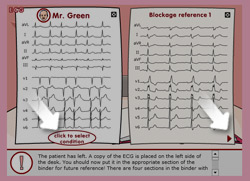
7.
First click on the patient's journal which appears to the left. Then click on one of the four sections in the reference book – choose between blockage, arrhythmia (rhythm disturbances), normal and healthy condition, and cardiac infarction!
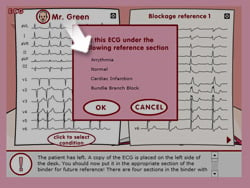
8.
Click on page 1 and 2 to compare your patient's ECG with the references. If you want to compare your patient's ECG with another reference you have to click on "Close book" and then choose another reference/section of the book.
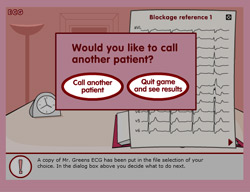
9.
When you know what the patient's ECG show, click on "Click to select condition" and mark one of the four suggestions that appear.
If you after this will proceed with the other three patients, answer "Yes" when the question "Would you like to call another patient?" appear.
KEY:
Mr. Yellow - Blockage
Mr. Green - Arrhythmia
Mr. Red – Cardiac infarction
Mr. Blue - Normal heart condition
MLA style: "Electrocardiogram". Nobelprize.org. Nobel Prize Outreach AB 2022. <http://nobel-external-educationalgames-app.azurewebsites.net/educational/medicine/ecg/help.php?objectname=%2Feducational%2Fchemistry%2Fchiral%2F>